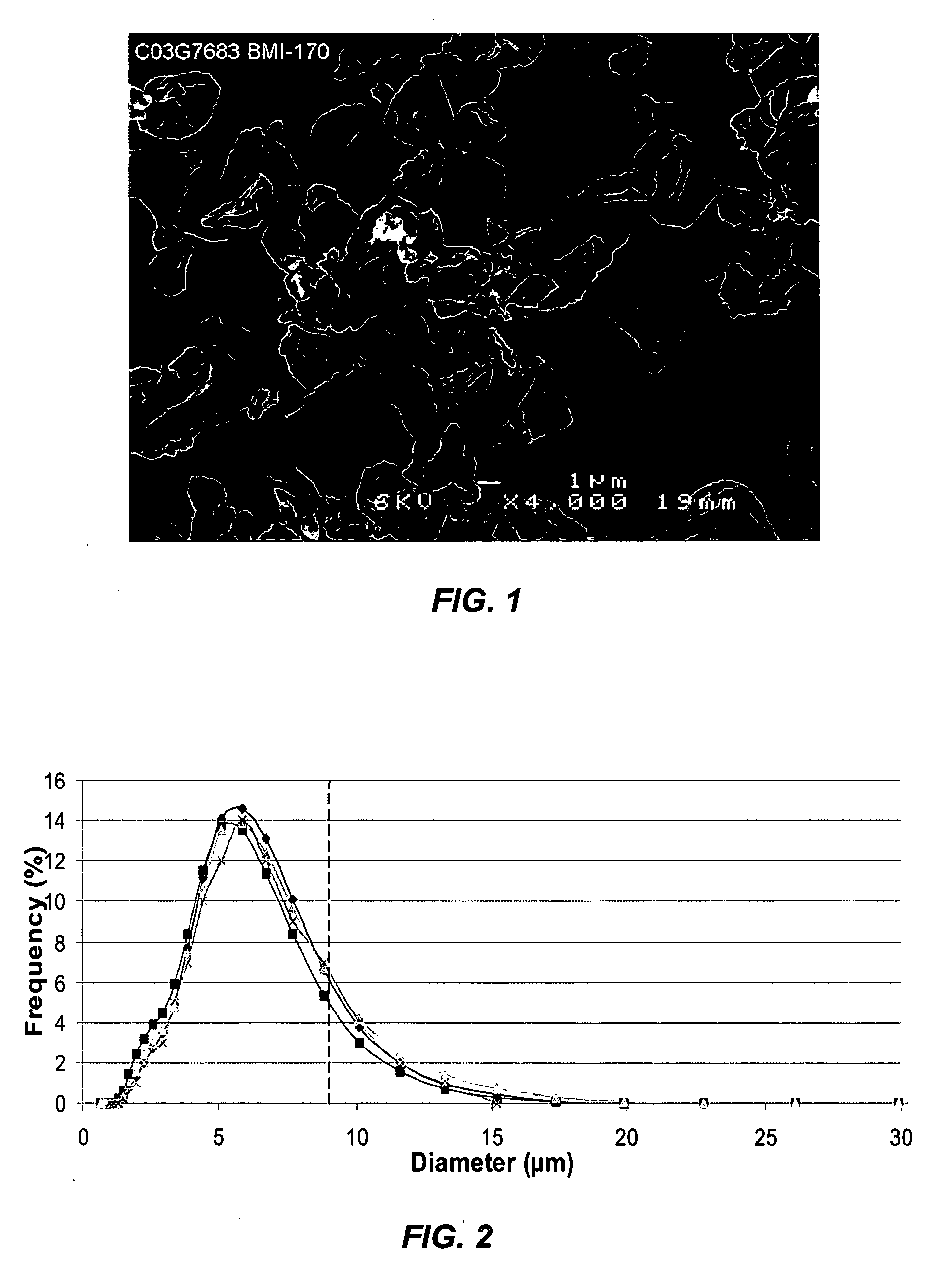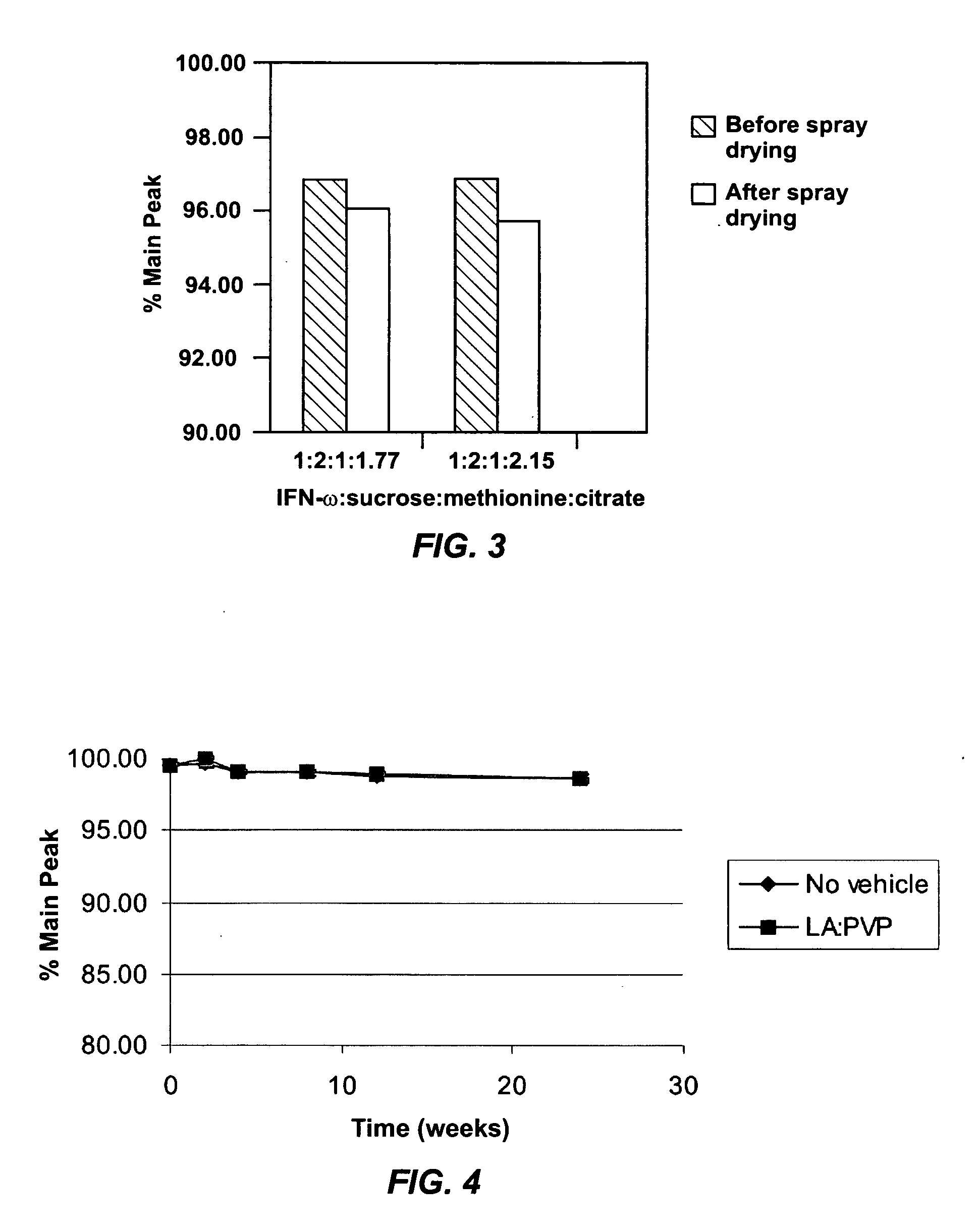Implantable device for continuous delivery of interferon
a technology of interferon and implantable devices, which is applied in the direction of peptide/protein ingredients, implants, medical conditions, etc., can solve the problems of difficult design of protein formulations that are stable at elevated temperature difficult to design protein formulations that are stable for a long time at elevated temperature, and difficult to design
- Summary
- Abstract
- Description
- Claims
- Application Information
AI Technical Summary
Benefits of technology
Problems solved by technology
Method used
Image
Examples
example 1
[0045] A bulk solution of IFN-ω was obtained as a frozen solution having a concentration of approximately 5 mg / ml. The IFN-ω solution was dialyzed against 25 mM citrate solution (pH 6.0). Sucrose and methionine in citrate solution were added to the dialyzed IFN-ω to make final IFN-ω:sucrose:methionine:citrate in a ratio of 1:2:1:1.77. The solution was spray dried as described above. The average particle size was 4-5 μm. The spray solution and spray dried particles were analyzed using RP-HPLC. The first two bars of FIG. 3 show percent main peak for the spray solution and spray dried particles of this example. Percent main peak refers to the fraction of IFN-ω detected that is in a monomeric form and does not appear to be chemically degraded in any form
example 2
[0046] A bulk solution of IFN-ω was obtained as a frozen solution having a concentration of approximately 5 mg / ml. The IFN-ω solution was dialyzed against 25 mM citrate solution (pH 6.0). Sucrose and methionine in citrate solution were added to the dialyzed IFN-ω to make final IFN-ω:sucrose:methionine:citrate in a ratio of 1:2:1:2.15. The solution was spray dried as described above. The average particle size was 4-5 μm. The spray solution and spray dried particles were analyzed using RP-HPLC. The second two bars of FIG. 3 show percent main peak for the spray solution and spray dried particles of this example.
example 3
[0047] A bulk solution of IFN-ω was obtained as a frozen solution having a concentration of approximately 5 mg / ml. The IFN-ω solution was dialyzed against 25 mM citrate solution (pH 6.0). Sucrose and methionine in citrate solution were added to the dialyzed IFN-ω to make final IFN-ω:sucrose:methionine:citrate in a ratio of 1:2:1:2.2 at IFN-ω concentration of 3.3 mg / mL. The solution was spray dried as described above. The spray dried particles were evaluated using RP-HPLC and SEC at various timepoints during storage. The results are shown in Tables 3 and 4 below.
TABLE 3RP-HPLCProteinSEC MonomerMain PeakContentTemperature(Standard(Standard(Standard(° C.)Time (months)Deviation)Deviation)Deviation)A (n = 15)0100.00 (0.01) 96.26 (0.39)16.11 (0.21)B (n = 3)40199.85 (0.00)96.99 (0.19)16.47 (0.07)C (n = 3)40299.90 (0.01)95.85 (0.01)16.16 (0.22)D (n = 3)40399.93 (0.02)96.45 (0.35)16.51 (0.22)E (n = 3)40699.88 (0.00)95.24 (0.12)17.01 (0.13)F (n = 3)25699.93 (0.01)96.20 (0.10)17.14 (0.14)G (...
PUM
| Property | Measurement | Unit |
|---|---|---|
| weight ratio | aaaaa | aaaaa |
| wt % | aaaaa | aaaaa |
| wt % | aaaaa | aaaaa |
Abstract
Description
Claims
Application Information
 Login to View More
Login to View More - R&D
- Intellectual Property
- Life Sciences
- Materials
- Tech Scout
- Unparalleled Data Quality
- Higher Quality Content
- 60% Fewer Hallucinations
Browse by: Latest US Patents, China's latest patents, Technical Efficacy Thesaurus, Application Domain, Technology Topic, Popular Technical Reports.
© 2025 PatSnap. All rights reserved.Legal|Privacy policy|Modern Slavery Act Transparency Statement|Sitemap|About US| Contact US: help@patsnap.com



